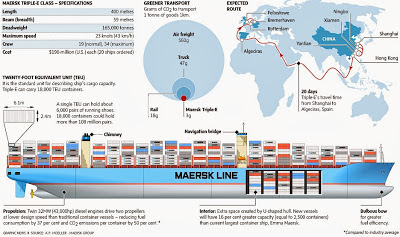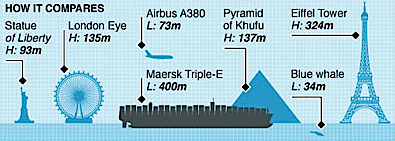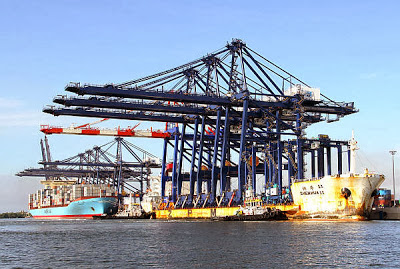Thursday, December 12. 2013
(Joking) note: does somebody came up with some sort of Moore's law regarding the size of these ships? Will there be a "singularity" too with container boats? Maybe a point where they will be able to contain the "captive globe"?
-----
La taille des nouveaux porte-containers fait comprendre que la notion de Mega Mobil Factory n'est pas seulement une fiction comme certains très beaux projets pourraient le laisser croire - voir " New Offshore Nomadic City ?" ou " Salt Eater Moving Machine" - mais bien une réalité en marche.
Avec la nouvelle classe des Triple-E et notamment le Maerks Mc-Kinney Moller, nous avons faire à un nouvelle catégorie de machines qui va peu à peu bouleverser nos façons de penser ce qui peut se réaliser sur un bateau, et donc ce à quoi pourraient devenir les navires dans futur. Car tout comme le paquebot de croisière a transformé un moyen de transport en un lieu de destination ( d'un bateau en un club de vacances), la mutation des porte-containers annoncent peut-être d'autres évolutions plus radicales tel le projet BlueSeed dont je vous ai parlé dans mon précédents post. Pourquoi, en effet, ne pas imaginer que le porte-containers passe du statut de moyen de transport à celui de lieu de production off shore ? Les containers passerait du statut de boite à celui de lieu de production - voir là, là et là -, soit sous sous forme de mini factory (un ou deux containers) soit de mega factory par l'assemblage de plusieurs dizaines de containers. On est loin d'être là aujourd'hui, mais la révolution industrielle en cours - voir " Micro-multinationale du futur ?" et là - va peut être changer les choses.
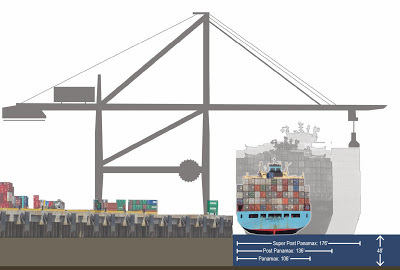
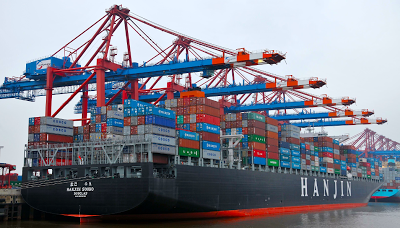
Ce qui est certain c'est que ces nouvelles classes de porte-containers perturbent tout, nos grilles de lectures, mais aussi les infrastructures terrestres. Les ports ont, en effet, de plus en plus de mal à adapter leurs équipement, et notamment leurs grues, à ce gonflement incessant de plus en plus rapide du gabarits des nouvelles générations de navires.
L'évolution est tellement rapide que certains ports, et pas forcément les moins performants, sont obligés de faire appel à des méga bateaux grues pour décharger les porte containers qui font escale chez eux - voir par exemple Miami, là.



Les ports qui avaient déjà perdu leurs bâtiments, les docks ou les hangars, depuis vingt ans avec l'apparition des containers vont peut-être bientôt perdre leurs grues. Pourquoi en effet continuer à investir dans des grues s'il faut les changer tous les 10 ans ? C'est quoi un port dans ces conditions là ? L’espace portuaire, entièrement dédié aux containers, ne tolère plus aujourd'hui tout ce qui est fixe ou impossible à déplacer. Mais demain c'est peut-être les ports qui seront nomade. En effet, on retrouve aujourd'hui à terre, les logiques portuaires que développe l' US Navy au large avec ses ports mobiles - voir " Quand les bateaux deviennent des ports".

Et l'on peut-être tenté de se demander si, tout comme le container a détruit le port en le transformant en un simple parking à boites, le porte-containers ne pourrait pas à terme détruire non seulement les ports mais aussi une partie du tissus industriel statique et terrestre en devenant lui-même une mega factory flottante via des containers transformés en mini-usines ?
Bref, et dit autrement, et si notre futur industriel s'écrivait entre cela et cela ?
L'hypothèse n'est aujourd'hui qu'une pure hypothèse, mais il ne faut jamais oublier le rôle défricheur des militaires dans l'évolution de la mobilité.
Et pour continuer à réfléchir sur le rôle des containers dans l'économie et le système productif mondial, je ne peux que vous inciter à regarder :
Tuesday, December 10. 2013
Via The New Aesthetic (via Algopop)
-----
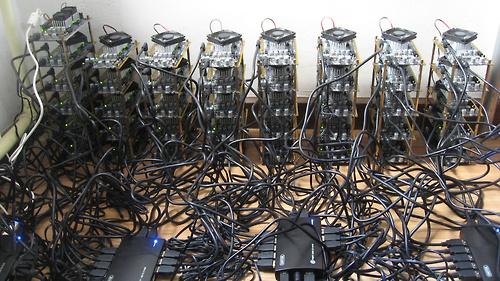
The World’s Most Powerful Computer Network Is Being Wasted on Bitcoin, via algopop
Because of the way Bitcoin self-regulates, the math problems Bitcoin mining rigs have to do to get more ‘coin get harder and harder as time goes on. Not to any particular end, but just to make sure the world doesn’t get flooded with Bitcoins. So all these computers aren’t really accomplishing anything other than solving super difficult and necessarily arbitrary puzzles for cyber money. It’s kind of like rounding up the world’s greatest minds and making them do Sudokus for nickels.
Projects like Folding@Home and SETI@Home use similarly networked power for the less-pointless practices of parsing information that could lead to more effective medicines or finding extra-terrestrial life, respectively, and either are hard-pressed to scrounge up even half of a percent of the power the Bitcoin network is rocking. And with specialized Bitcoin-mining hardware on the rise, there’s going to be an army of totally powerhouse PCs out there that are good for literally nothing but digging up cybercoins.
It’s incredible to think about the amount of power being directed at this one, singular purpose; power that’s essentially being “donated” by thousands of people across the globe just because they have skin in the game. It’s by far the most computational effort that has ever been devoted to a single purpose. And sure, Bitcoins are fine and all, but can you imagine what we could do if this energy was put behind other tough problems? We’ll you’re going to have to imagine, because so long as mining Bitcoins can earn you money and folding proteins can’t, it’s pretty clear which one is gonna get done.
Thursday, December 05. 2013
Via Pasta & Vinegar
-----
By Nicolas
Being interested in the role of algorithms and their influence on everyday life, i started collecting examples under the #curiousrituals hashtag. Perhaps it’s a follow-up to Curious Rituals, perhaps it isn’t.
Some intriguing cases I’ve found recently (most of them comes from the non-scientific press, as i’m focusing on everyday life):
Music generated with script and played by fake users get a good ranking on online music charts
“Melbourne hacker and payments security professional Peter Filimore, who, it should be mentioned, cannot play or sing a single note, managed to accrue $1,000 in royalties and knock artists like Pink, Nicki Minaj, and Flume off high spots in online music charts through the use of bots.
In an effort to uncover security flaws in online streaming services like Spotify, Filimore decided to send “garbage” tunes to the top of the charts and generate royalties in the process. Filimore started by using algorithms to compile public domain audio and splicing cheesy MIDI tracks together.
Filimore then purchased three Amazon-linked compute instances — virtual servers that are able to run applications — and created a simple hacking script to simulate three listeners playing his songs 24-hours a day for a month, while accruing reviews that described his music as “rubbish.”
[...]
Filimore also explained that using a larger cluster of computing instances could potentially generate thousands of dollars in fraudulent royalties. “
Are Face-Detection Cameras Racist?
“When Joz Wang and her brother bought their mom a Nikon Coolpix S630 digital camera for Mother’s Day last year, they discovered what seemed to be a malfunction. Every time they took a portrait of each other smiling, a message flashed across the screen asking, “Did someone blink?” No one had. “I thought the camera was broken!” Wang, 33, recalls. But when her brother posed with his eyes open so wide that he looked “bug-eyed,” the messages stopped.
Wang, a Taiwanese-American strategy consultant who goes by the Web handle “jozjozjoz,” thought it was funny that the camera had difficulties figuring out when her family had their eyes open. So she posted a photo of the blink warning on her blog under the title, “Racist Camera! No, I did not blink… I’m just Asian!”“
Bot wars – The arms race of restaurant reservations in SF
“After a while of running this script I had captured a good amount of data. One day I found myself looking at it and noticed that as soon as reservations became available on the website (at 4am), all the good times were immediately taken and were gone by 4:01am. It quickly became obvious that these were reservation bots at work. [...] You fight fire with fire, so I made my own reservation bot. You can get the code here.
I used mechanize to create a simple ruby script that goes through the process of checking for available reservations (in a given time range) and making a reservation under your name.
With this script I was able to start getting reservations again, but I know that this bot war will continue to escalate.“
“Scans made by some Xerox copiers are changing numbers on documents, a German computer scientist has discovered. [...] He said the anomaly is caused by Jbig2, an image compression standard. Image compression is typically used to make file sizes smaller. Jbig2 would substitute figures it thought were the same, meaning similar numbers were being wrongly swapped.“
Google’s autocompletion: algorithms, stereotypes and accountability
You might have come across the latest UN Women awareness campaign. Originally in print, it has been spreading online for almost two days. It shows four women, each “silenced” with a screenshot from a particular Google search and its respective suggested autocompletions. [...] Guess what was the most common reaction of people?
They headed over to Google in order to check the “veracity” of the screenshots, and test the suggested autocompletions for a search for “Women should …” and other expressions.
This awareness campaign has been very successful in making people more aware of the sexism in our world Google’s autocomplete function.
When Roommates Were Random
As soon as today’s students receive their proverbial fat envelope from their top choice college, they are on Facebook meeting other potential freshmen. They are on sites like roomsurf.com and roomsync.com, scoping out prospective friends. By the time the roommate application forms arrive, many like-minded students with similar backgrounds have already connected and agreed to request one another.
It’s just one of many ways in which digital technologies now spill over into non-screen-based aspects of social experience. I know certain people who can’t bear to eat in a restaurant they haven’t researched on Yelp. And Google now tailors searches to exactly what it thinks you want to find.
But this loss of randomness is particularly unfortunate for college-age students, who should be trying on new hats and getting exposed to new and different ideas. Which students end up bunking with whom may seem trivial at first glance. But research on the phenomenon of peer influence — and the influences of roommates in particular — has found that there are, in fact, long-lasting effects of whom you end up living with your first year.
Why do I blog this? I’ve started collecting examples like this in the past few months. Might be the beginning of something, you never know. What I find intriguing here is that there are various types of influences for such algorithms: sometimes it’s a “framing” where the user’s agency is limited (the racist camera for instance), sometimes it’s not (you’re not forced to use recommendation engines). I’m thinking about building a typology perhaps, collecting these, talking to people, there’s a whole list to be built
Via MIT technology Review
-----
Forget robotic product delivery. As usual for Google, I suspect it’s all about the data.

Google-bot: The M1 Mobile Manipulator from Meka, one of several robot companies acquired recently by Google.
Google has quietly bought seven robotics companies, and has given Andy Rubin, the man who originally led the Android project, the job of developing Google’s first robot army. And so, the New York Times suggests it might only be a few years before a Google robot driving in a Google car is delivering products to your door.
I somehow doubt Google has anything quite so futuristic in mind. I think the effort is quite similar to both Google’s self-driving car endeavor and its Android project. In other words, it’s all about gaining a dominant position in markets where data is about to explode.
Take Google’s self-driving cars. Contrary to common perception, the company didn’t “invent” this technology; most carmakers were already working on autonomous system when Google got involved, and academic researchers had made dramatic recent progress—propelled in large part by several DARPA challenges (see “Driverless Cars are Further Away than You Think”). Google just saw that this was where the automotive industry was headed, and realized that the advent of automation, telematics, and communication would mean a tsunami of data that it could both supply and profit from. Given that many of us spend several hours a day in automobiles, this data could help Google learn more about users and tailor its products accordingly.
Similarly, I suspect Google has recognized that a new generation of smarter, safer, industrial robots is rapidly emerging (see “This Robot Could Transform Manufacturing” and “Why This Might be the Model-T of Workplace Robots”), and it’s realized that these bots could have a huge impact both at work and at home. Whoever provides the software that controls and manages these robots not only stands to make a fortune by selling that software; they will have access to a vast new repository of data about how we live and work.
In this sense, I think Google is being true to its stated mission: “to organize the world’s information”—although it’s worth noting that in an increasingly connected and data-rich world that could mean seeking to organize just about every aspect of our lives. Luckily for Google, it may soon have a robot army to help it keep everything in order.
Wednesday, December 04. 2013
Via Processing Matter
-----
Google no longer understands how its “deep learning” decision-making computer systems have made themselves so good at recognizing things in photos
(…)
The claims were made at the Machine Learning Conference in San Francisco on Friday by Google software engineer Quoc V. Le in a talk in which he outlined some of the ways the content-slurper is putting “deep learning” systems to work.
(…)
This means that for some things, Google researchers can no longer explain exactly how the system has learned to spot certain objects, because the programming appears to think independently from its creators, and its complex cognitive processes are inscrutable. This “thinking” is within an extremely narrow remit, but it is demonstrably effective and independently verifiable.
|


